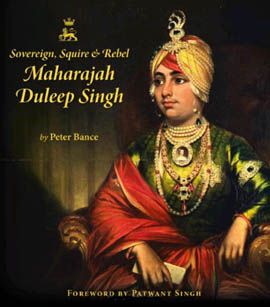An ill-starred Maharaja
Off the shelf
Reviewed by V. N. Datta
Sovereign, Squire and Rebel: Maharajah Duleep Singh
By Peter Bance.
Cornet House, London.
Pages 200. $49.
The Sunday Tribune: May 30, 2010
THIS book offers the blighted, tragic and pathetic life story of Maharaja Duleep Singh, his two wives and six children. The work is elegantly produced and profusely illustrated with over 250 rare photographic images culled from diverse sources, especially from India, Pakistan and England. The author Peter Bance, also known as Bhupender Singh Bance, operates a real estate business. He has previously written a book entitled Khalsa Jatha (1908-2008).
 Reading this book, one cannot but conclude that Duleep Singh’s life was random. He drifted from place to place not knowing where lay the harbour to launch his boat. He was a mere victim of adverse circumstances, swept off his feet by the rising tides of stormy seas. Does his story raise in us, the readers, a sense of pity, remorse or rage over the infirmity of his mind?
Reading this book, one cannot but conclude that Duleep Singh’s life was random. He drifted from place to place not knowing where lay the harbour to launch his boat. He was a mere victim of adverse circumstances, swept off his feet by the rising tides of stormy seas. Does his story raise in us, the readers, a sense of pity, remorse or rage over the infirmity of his mind?
Let us go over briefly the life-story of Maharaja Duleep Singh, which the author has presented in a lucid and straightforward style. Duleep Singh was barely 10 months old when he found himself installed on the golden throne of the Punjab kingdom, which his father, Maharaja Ranjit Singh, had created with consummate statesmanship and firm will.
At the age of eight, Duleep Singh was crowned as the sovereign of Panjab, which the British annexed in 1849. The British thought it necessary to separate Duleep from this mother Rani Jindan for the maintenance of peace in Panjab that seethed with discontent and rage. The British removed the beauteous Rani Jindan to Sheikhupura and then dragging and seizing her long hair, inhumanly sent her to Ferozepur in 1848, and finally to Banaras, from where she managed to escape to Kathmandu in Nepal. Finally, she was cremated in Nasik in 1864 on the Panchvati side of the river.
On the command of the diehard imperialist Governor-General Lord Dalhousie, Duleep Singh shuttled from one place to another: Fatehgarh, Mussoorie, Agra, Meerut, Roorki, and Hardwar. He was converted to Christianity; and Dalhousie presented to him a copy of the Bible on April 4, 1854, at Barrackpore in Bengal. In order to destroy Duleep Singh’s influence in the Panjab, Dalhousie dispatched him to England. Duleep Singh met the Queen Victoria at Buckingham Palace and became a frequent visitor at Windsor Palace. When he visited India in 1853, his entry was banned in the Panjab. On his death in Paris, The Tribune wrote on October 25, 1893, that "there was no one in the hotel room to close his eyes".
Does the present study offer any new information or interpretation of the life of Duleep Singh and his heirs? Michael Alexander and Sushila Anand (1980) present Maharaja Duleep Singh as an object of pity and ridicule, almost a puppet in the British hands to delight their whims and caprices and dying a dissipated and broken man. In another work, Duleep Singh (1884), Leena Login defends Duleep Singh’s loyalty to the British government.
In 1977, Dr Ganda Singh published Maharaja Duleep Singh: Correspondence, a sound and solid work of documentary scholarship of 731 pages. According to Ganda Singh, Duleep Singh was worst hit unjustly by the British for no fault of his, when there was absolutely no need for them to do so.
Bance highlights how after the annexation of the Panjab, the British looted, pillaged and robbed the Panjab of some of the more precious objects of admiration and reverence, including Guru Gobind Singh’s Kalgi (the plume), the famed Koh-i-Noor which was to become the crown jewel of Queen Victoria and Shah Shujah’s gorgeously embroidered pavilion.
The merit of Peter Bances book lies in his visiting and identifying the sites where Duleep Singh and his family lived. He also gives us a glimpse of the type of life the family led under strained financial circumstances. Throughout the period, the family continued to ask for more largesse form the British government.
The author presents Duleep Singh as a thoroughly Victorian English country gentleman at large, wallowing in luxury and easy living, spending on his ostentatious lifestyle more than he could afford and thereby incurring heavy debts, much to his discomfiture. A hard drinker, Duleep Singh was accustomed to visiting notorious haunts and music halls in England and Europe. He wasted his wealth and frittered away his energy on frivolous social activities.
The author shows that in the last phase of his life, Duleep Singh saw through the crafty British game. That is why he raised his banner of revolt. He was reinitiated into Sikhism on May 25, 1886, thereby abjuring his Christian faith. Accusing the British of denying him his legitimate financial interests, he claimed the right to own the Pind Dadan Khan Salt mines, which were rated at $ 40,000 a year.
Feeling utterly helpless Duleep Singh went to Moscow in early September 1888 and solicited military aid of 10,000 soldiers from the Czar Alexander III to invade India through Afghanistan, but his hopes were dashed.
There is nothing significant about his heirs. None of his children had any issue. Duleep Singh’s last descendent Princess Bamba Sutherland, who styled herself as the ‘Queen of Panjab’ could not get a seat on the bus in Lahore where she died in March 1957.
This work lacks analysis and depth—it is just a plain narrative, a story woven by the author. It does not explain or analyse but only evokes and describes.